Report: Consumer Behaviour and Insight for Airdri Hand Dryers, UK
VerifiedAdded on 2023/02/02
|8
|2186
|90
Report
AI Summary
This report provides a comprehensive analysis of consumer behavior, specifically focusing on the Airdri firm, a provider of hand dryers in the United Kingdom. It delves into the stages of consumer decision-making, emphasizing the importance of mapping the path to purchase and understanding consumer behavior. The report outlines various models of consumer decision-making, including the Nicosia and Economic models, and explores the decision-making process for a specific product or service. It examines levels of consumer decision-making, such as extensive, limited, and routinized problem-solving, and identifies factors that influence consumer choices, including personal, purchasing power, and cultural factors. The report concludes by highlighting the significance of consumer behavior in marketing and the importance of aligning product development with consumer needs and demands.
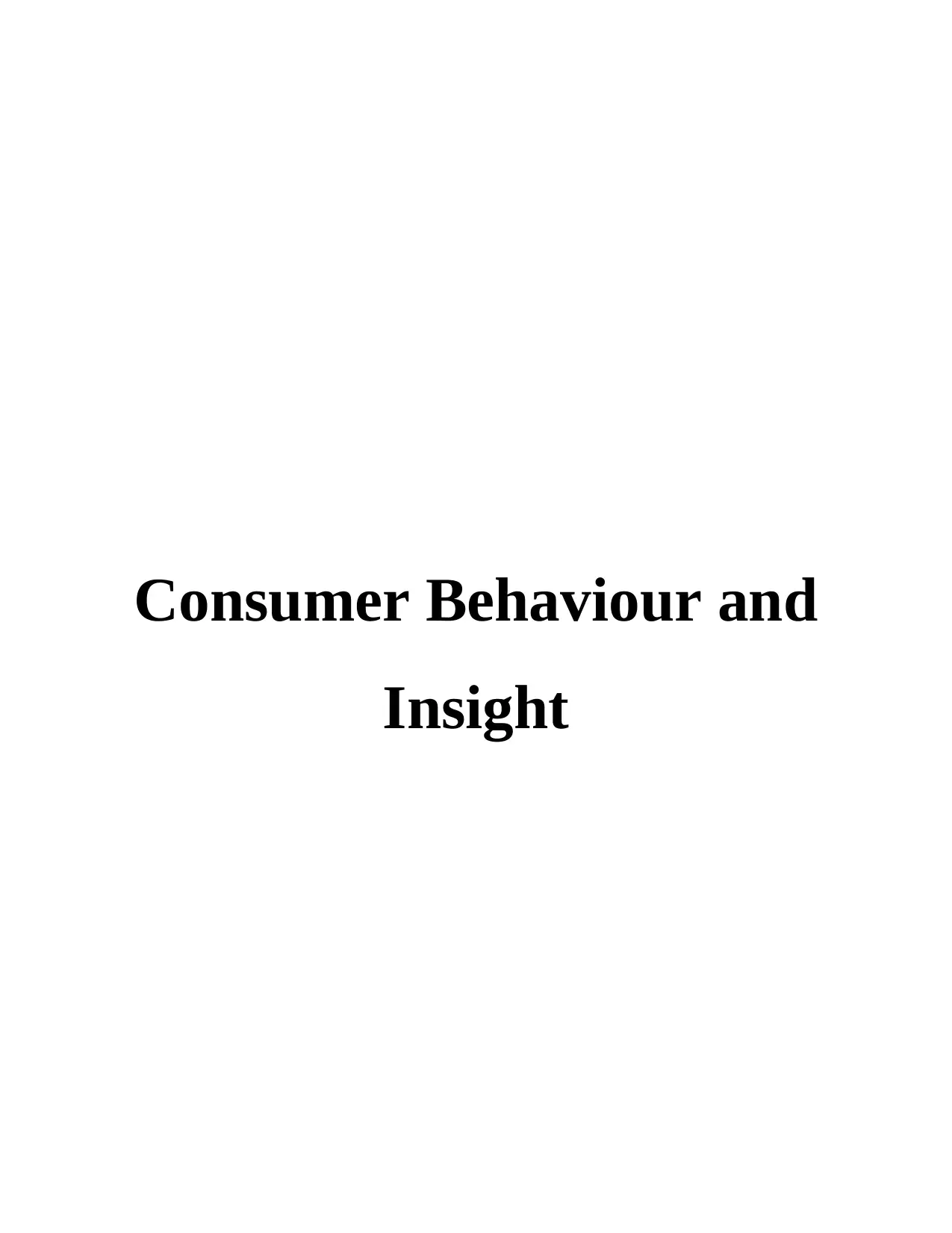
Consumer Behaviour and
Insight
Insight
Paraphrase This Document
Need a fresh take? Get an instant paraphrase of this document with our AI Paraphraser
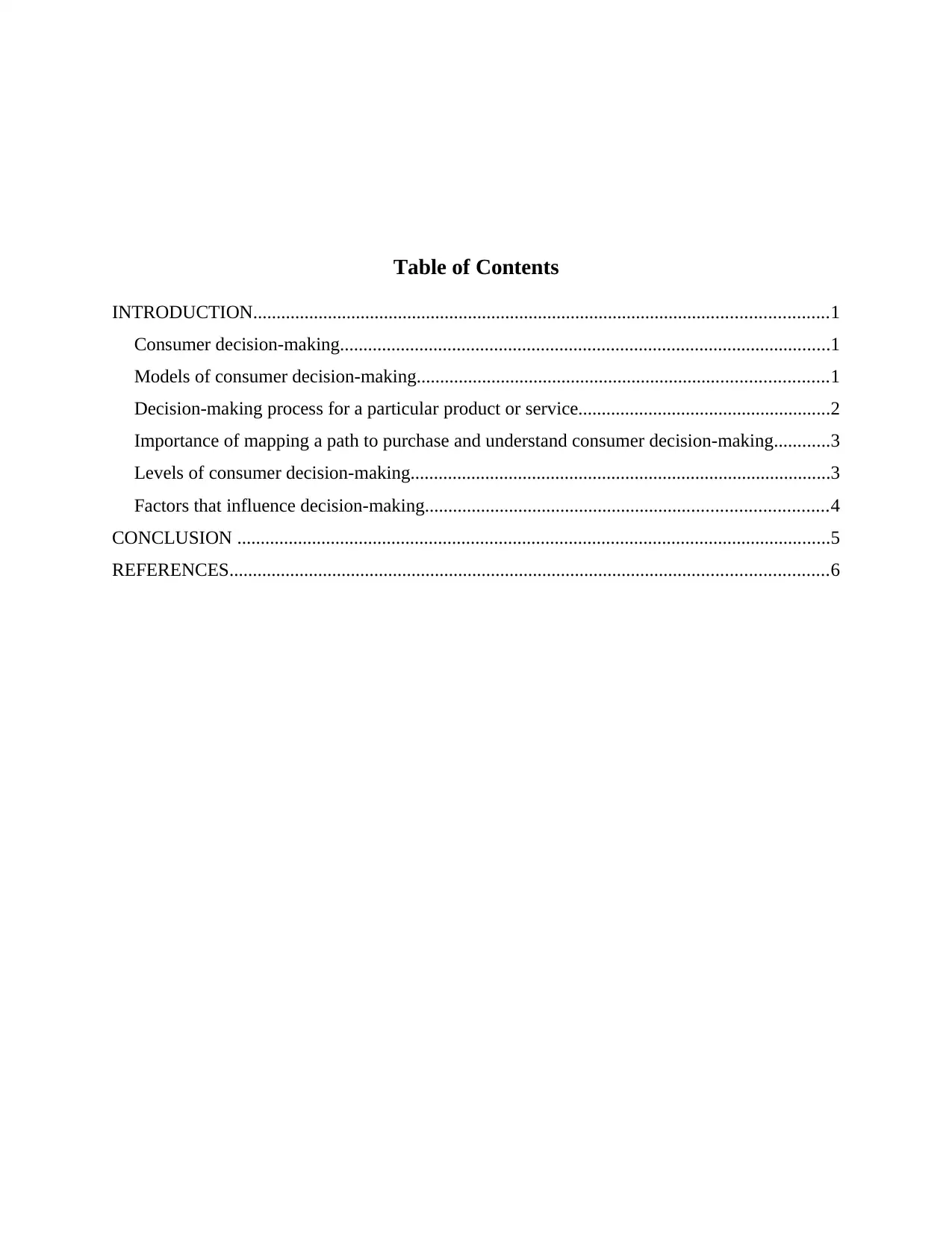
Table of Contents
INTRODUCTION...........................................................................................................................1
Consumer decision-making.........................................................................................................1
Models of consumer decision-making........................................................................................1
Decision-making process for a particular product or service......................................................2
Importance of mapping a path to purchase and understand consumer decision-making............3
Levels of consumer decision-making..........................................................................................3
Factors that influence decision-making......................................................................................4
CONCLUSION ...............................................................................................................................5
REFERENCES................................................................................................................................6
INTRODUCTION...........................................................................................................................1
Consumer decision-making.........................................................................................................1
Models of consumer decision-making........................................................................................1
Decision-making process for a particular product or service......................................................2
Importance of mapping a path to purchase and understand consumer decision-making............3
Levels of consumer decision-making..........................................................................................3
Factors that influence decision-making......................................................................................4
CONCLUSION ...............................................................................................................................5
REFERENCES................................................................................................................................6
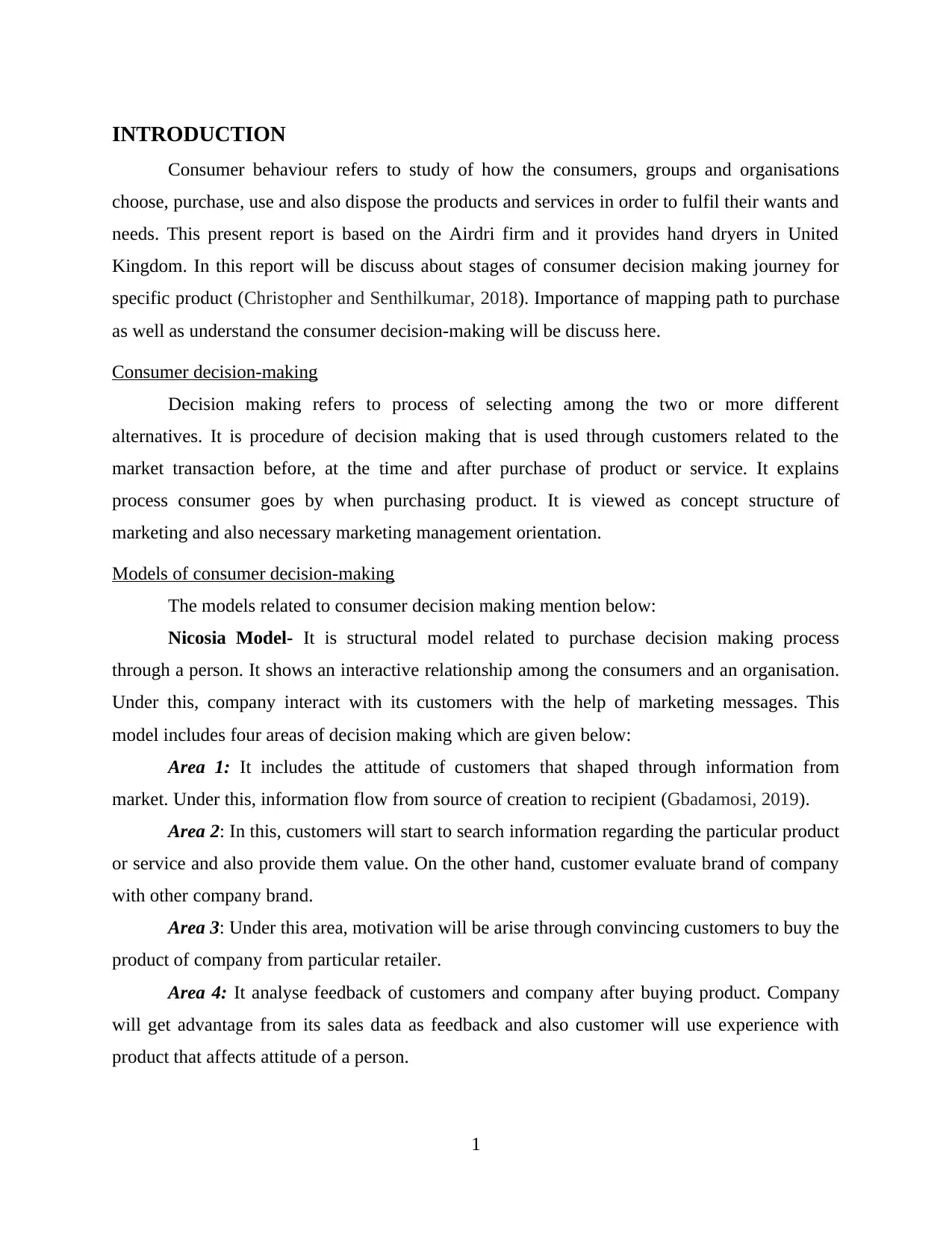
INTRODUCTION
Consumer behaviour refers to study of how the consumers, groups and organisations
choose, purchase, use and also dispose the products and services in order to fulfil their wants and
needs. This present report is based on the Airdri firm and it provides hand dryers in United
Kingdom. In this report will be discuss about stages of consumer decision making journey for
specific product (Christopher and Senthilkumar, 2018). Importance of mapping path to purchase
as well as understand the consumer decision-making will be discuss here.
Consumer decision-making
Decision making refers to process of selecting among the two or more different
alternatives. It is procedure of decision making that is used through customers related to the
market transaction before, at the time and after purchase of product or service. It explains
process consumer goes by when purchasing product. It is viewed as concept structure of
marketing and also necessary marketing management orientation.
Models of consumer decision-making
The models related to consumer decision making mention below:
Nicosia Model- It is structural model related to purchase decision making process
through a person. It shows an interactive relationship among the consumers and an organisation.
Under this, company interact with its customers with the help of marketing messages. This
model includes four areas of decision making which are given below:
Area 1: It includes the attitude of customers that shaped through information from
market. Under this, information flow from source of creation to recipient (Gbadamosi, 2019).
Area 2: In this, customers will start to search information regarding the particular product
or service and also provide them value. On the other hand, customer evaluate brand of company
with other company brand.
Area 3: Under this area, motivation will be arise through convincing customers to buy the
product of company from particular retailer.
Area 4: It analyse feedback of customers and company after buying product. Company
will get advantage from its sales data as feedback and also customer will use experience with
product that affects attitude of a person.
1
Consumer behaviour refers to study of how the consumers, groups and organisations
choose, purchase, use and also dispose the products and services in order to fulfil their wants and
needs. This present report is based on the Airdri firm and it provides hand dryers in United
Kingdom. In this report will be discuss about stages of consumer decision making journey for
specific product (Christopher and Senthilkumar, 2018). Importance of mapping path to purchase
as well as understand the consumer decision-making will be discuss here.
Consumer decision-making
Decision making refers to process of selecting among the two or more different
alternatives. It is procedure of decision making that is used through customers related to the
market transaction before, at the time and after purchase of product or service. It explains
process consumer goes by when purchasing product. It is viewed as concept structure of
marketing and also necessary marketing management orientation.
Models of consumer decision-making
The models related to consumer decision making mention below:
Nicosia Model- It is structural model related to purchase decision making process
through a person. It shows an interactive relationship among the consumers and an organisation.
Under this, company interact with its customers with the help of marketing messages. This
model includes four areas of decision making which are given below:
Area 1: It includes the attitude of customers that shaped through information from
market. Under this, information flow from source of creation to recipient (Gbadamosi, 2019).
Area 2: In this, customers will start to search information regarding the particular product
or service and also provide them value. On the other hand, customer evaluate brand of company
with other company brand.
Area 3: Under this area, motivation will be arise through convincing customers to buy the
product of company from particular retailer.
Area 4: It analyse feedback of customers and company after buying product. Company
will get advantage from its sales data as feedback and also customer will use experience with
product that affects attitude of a person.
1
⊘ This is a preview!⊘
Do you want full access?
Subscribe today to unlock all pages.

Trusted by 1+ million students worldwide
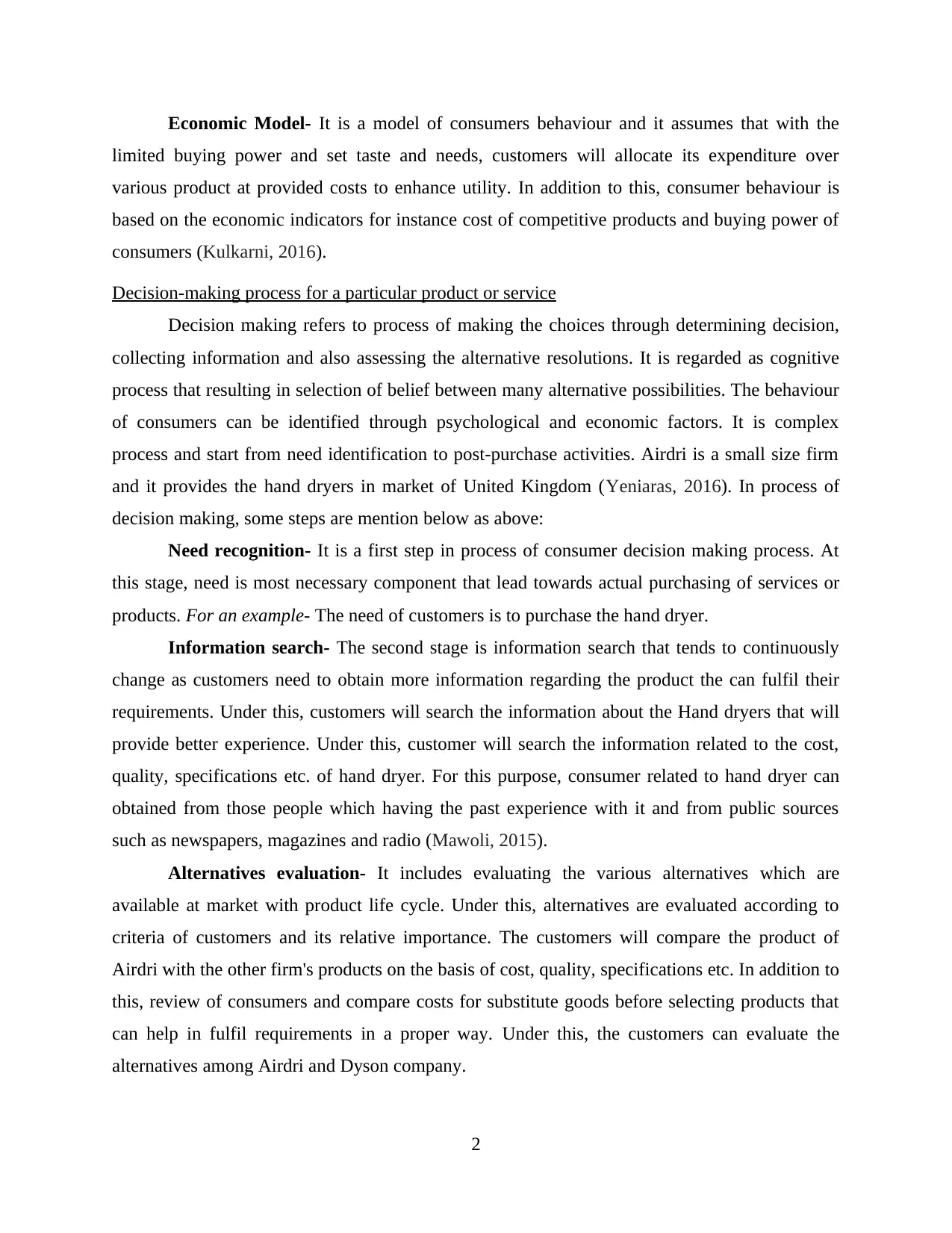
Economic Model- It is a model of consumers behaviour and it assumes that with the
limited buying power and set taste and needs, customers will allocate its expenditure over
various product at provided costs to enhance utility. In addition to this, consumer behaviour is
based on the economic indicators for instance cost of competitive products and buying power of
consumers (Kulkarni, 2016).
Decision-making process for a particular product or service
Decision making refers to process of making the choices through determining decision,
collecting information and also assessing the alternative resolutions. It is regarded as cognitive
process that resulting in selection of belief between many alternative possibilities. The behaviour
of consumers can be identified through psychological and economic factors. It is complex
process and start from need identification to post-purchase activities. Airdri is a small size firm
and it provides the hand dryers in market of United Kingdom (Yeniaras, 2016). In process of
decision making, some steps are mention below as above:
Need recognition- It is a first step in process of consumer decision making process. At
this stage, need is most necessary component that lead towards actual purchasing of services or
products. For an example- The need of customers is to purchase the hand dryer.
Information search- The second stage is information search that tends to continuously
change as customers need to obtain more information regarding the product the can fulfil their
requirements. Under this, customers will search the information about the Hand dryers that will
provide better experience. Under this, customer will search the information related to the cost,
quality, specifications etc. of hand dryer. For this purpose, consumer related to hand dryer can
obtained from those people which having the past experience with it and from public sources
such as newspapers, magazines and radio (Mawoli, 2015).
Alternatives evaluation- It includes evaluating the various alternatives which are
available at market with product life cycle. Under this, alternatives are evaluated according to
criteria of customers and its relative importance. The customers will compare the product of
Airdri with the other firm's products on the basis of cost, quality, specifications etc. In addition to
this, review of consumers and compare costs for substitute goods before selecting products that
can help in fulfil requirements in a proper way. Under this, the customers can evaluate the
alternatives among Airdri and Dyson company.
2
limited buying power and set taste and needs, customers will allocate its expenditure over
various product at provided costs to enhance utility. In addition to this, consumer behaviour is
based on the economic indicators for instance cost of competitive products and buying power of
consumers (Kulkarni, 2016).
Decision-making process for a particular product or service
Decision making refers to process of making the choices through determining decision,
collecting information and also assessing the alternative resolutions. It is regarded as cognitive
process that resulting in selection of belief between many alternative possibilities. The behaviour
of consumers can be identified through psychological and economic factors. It is complex
process and start from need identification to post-purchase activities. Airdri is a small size firm
and it provides the hand dryers in market of United Kingdom (Yeniaras, 2016). In process of
decision making, some steps are mention below as above:
Need recognition- It is a first step in process of consumer decision making process. At
this stage, need is most necessary component that lead towards actual purchasing of services or
products. For an example- The need of customers is to purchase the hand dryer.
Information search- The second stage is information search that tends to continuously
change as customers need to obtain more information regarding the product the can fulfil their
requirements. Under this, customers will search the information about the Hand dryers that will
provide better experience. Under this, customer will search the information related to the cost,
quality, specifications etc. of hand dryer. For this purpose, consumer related to hand dryer can
obtained from those people which having the past experience with it and from public sources
such as newspapers, magazines and radio (Mawoli, 2015).
Alternatives evaluation- It includes evaluating the various alternatives which are
available at market with product life cycle. Under this, alternatives are evaluated according to
criteria of customers and its relative importance. The customers will compare the product of
Airdri with the other firm's products on the basis of cost, quality, specifications etc. In addition to
this, review of consumers and compare costs for substitute goods before selecting products that
can help in fulfil requirements in a proper way. Under this, the customers can evaluate the
alternatives among Airdri and Dyson company.
2
Paraphrase This Document
Need a fresh take? Get an instant paraphrase of this document with our AI Paraphraser
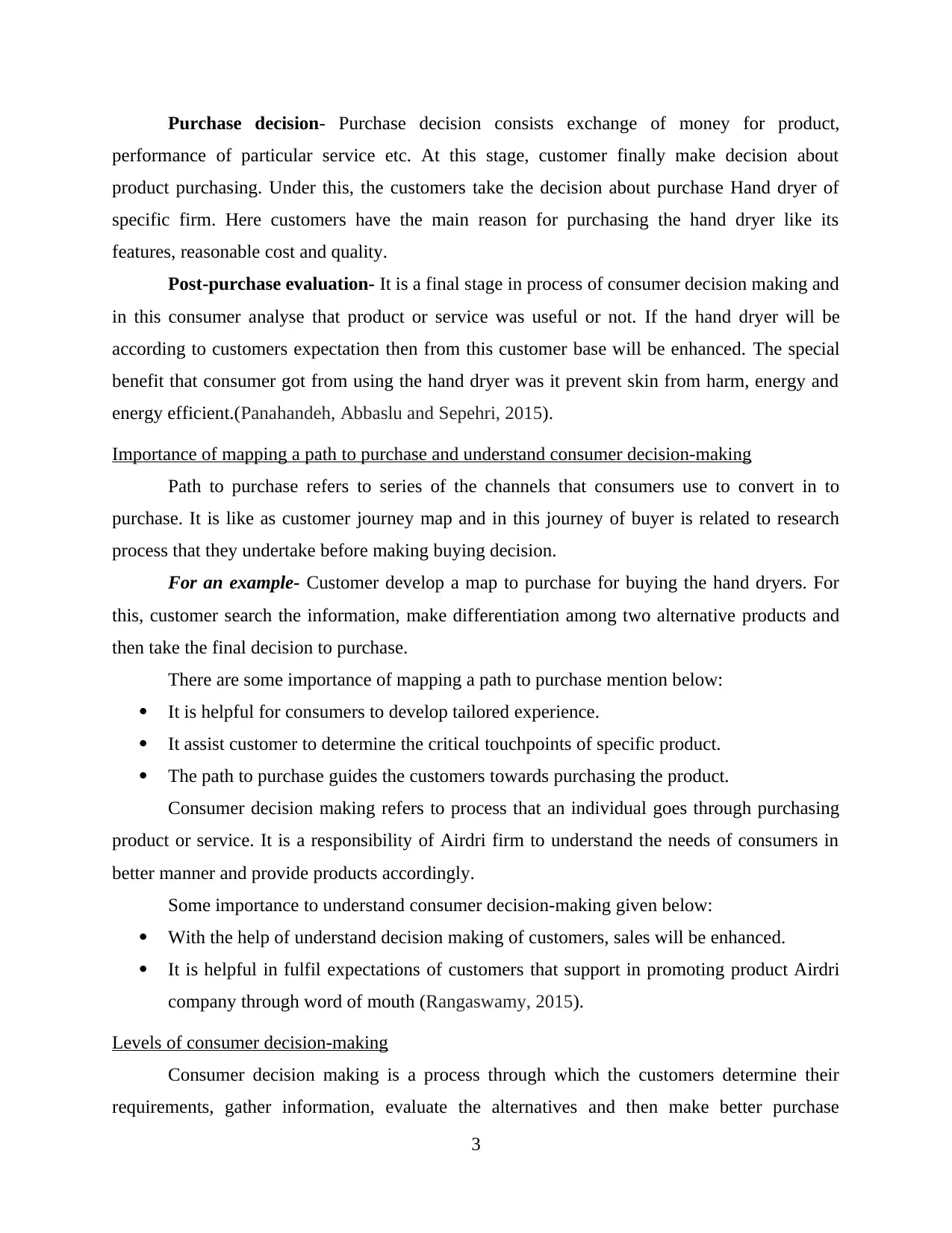
Purchase decision- Purchase decision consists exchange of money for product,
performance of particular service etc. At this stage, customer finally make decision about
product purchasing. Under this, the customers take the decision about purchase Hand dryer of
specific firm. Here customers have the main reason for purchasing the hand dryer like its
features, reasonable cost and quality.
Post-purchase evaluation- It is a final stage in process of consumer decision making and
in this consumer analyse that product or service was useful or not. If the hand dryer will be
according to customers expectation then from this customer base will be enhanced. The special
benefit that consumer got from using the hand dryer was it prevent skin from harm, energy and
energy efficient.(Panahandeh, Abbaslu and Sepehri, 2015).
Importance of mapping a path to purchase and understand consumer decision-making
Path to purchase refers to series of the channels that consumers use to convert in to
purchase. It is like as customer journey map and in this journey of buyer is related to research
process that they undertake before making buying decision.
For an example- Customer develop a map to purchase for buying the hand dryers. For
this, customer search the information, make differentiation among two alternative products and
then take the final decision to purchase.
There are some importance of mapping a path to purchase mention below:
It is helpful for consumers to develop tailored experience.
It assist customer to determine the critical touchpoints of specific product.
The path to purchase guides the customers towards purchasing the product.
Consumer decision making refers to process that an individual goes through purchasing
product or service. It is a responsibility of Airdri firm to understand the needs of consumers in
better manner and provide products accordingly.
Some importance to understand consumer decision-making given below:
With the help of understand decision making of customers, sales will be enhanced.
It is helpful in fulfil expectations of customers that support in promoting product Airdri
company through word of mouth (Rangaswamy, 2015).
Levels of consumer decision-making
Consumer decision making is a process through which the customers determine their
requirements, gather information, evaluate the alternatives and then make better purchase
3
performance of particular service etc. At this stage, customer finally make decision about
product purchasing. Under this, the customers take the decision about purchase Hand dryer of
specific firm. Here customers have the main reason for purchasing the hand dryer like its
features, reasonable cost and quality.
Post-purchase evaluation- It is a final stage in process of consumer decision making and
in this consumer analyse that product or service was useful or not. If the hand dryer will be
according to customers expectation then from this customer base will be enhanced. The special
benefit that consumer got from using the hand dryer was it prevent skin from harm, energy and
energy efficient.(Panahandeh, Abbaslu and Sepehri, 2015).
Importance of mapping a path to purchase and understand consumer decision-making
Path to purchase refers to series of the channels that consumers use to convert in to
purchase. It is like as customer journey map and in this journey of buyer is related to research
process that they undertake before making buying decision.
For an example- Customer develop a map to purchase for buying the hand dryers. For
this, customer search the information, make differentiation among two alternative products and
then take the final decision to purchase.
There are some importance of mapping a path to purchase mention below:
It is helpful for consumers to develop tailored experience.
It assist customer to determine the critical touchpoints of specific product.
The path to purchase guides the customers towards purchasing the product.
Consumer decision making refers to process that an individual goes through purchasing
product or service. It is a responsibility of Airdri firm to understand the needs of consumers in
better manner and provide products accordingly.
Some importance to understand consumer decision-making given below:
With the help of understand decision making of customers, sales will be enhanced.
It is helpful in fulfil expectations of customers that support in promoting product Airdri
company through word of mouth (Rangaswamy, 2015).
Levels of consumer decision-making
Consumer decision making is a process through which the customers determine their
requirements, gather information, evaluate the alternatives and then make better purchase
3
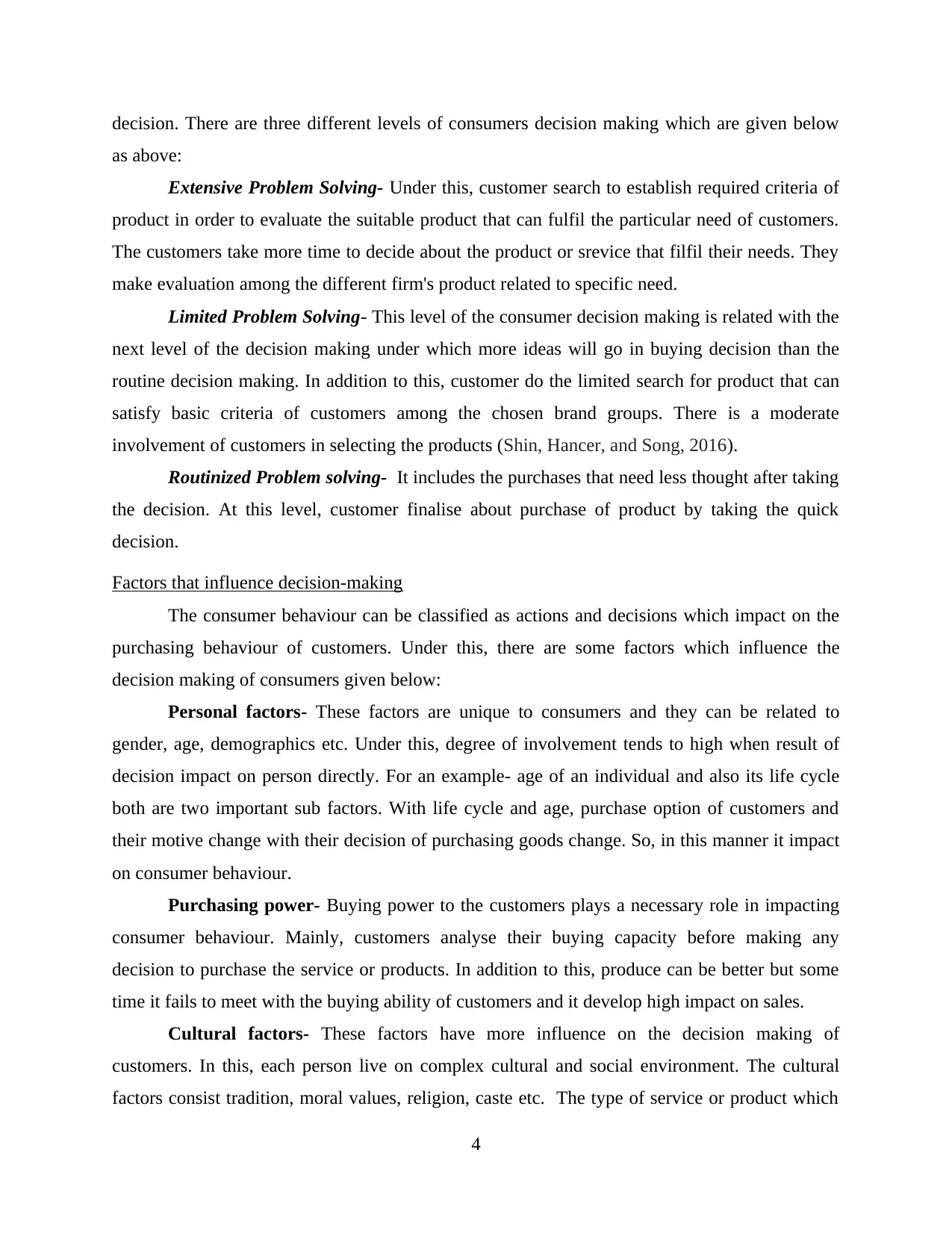
decision. There are three different levels of consumers decision making which are given below
as above:
Extensive Problem Solving- Under this, customer search to establish required criteria of
product in order to evaluate the suitable product that can fulfil the particular need of customers.
The customers take more time to decide about the product or srevice that filfil their needs. They
make evaluation among the different firm's product related to specific need.
Limited Problem Solving- This level of the consumer decision making is related with the
next level of the decision making under which more ideas will go in buying decision than the
routine decision making. In addition to this, customer do the limited search for product that can
satisfy basic criteria of customers among the chosen brand groups. There is a moderate
involvement of customers in selecting the products (Shin, Hancer, and Song, 2016).
Routinized Problem solving- It includes the purchases that need less thought after taking
the decision. At this level, customer finalise about purchase of product by taking the quick
decision.
Factors that influence decision-making
The consumer behaviour can be classified as actions and decisions which impact on the
purchasing behaviour of customers. Under this, there are some factors which influence the
decision making of consumers given below:
Personal factors- These factors are unique to consumers and they can be related to
gender, age, demographics etc. Under this, degree of involvement tends to high when result of
decision impact on person directly. For an example- age of an individual and also its life cycle
both are two important sub factors. With life cycle and age, purchase option of customers and
their motive change with their decision of purchasing goods change. So, in this manner it impact
on consumer behaviour.
Purchasing power- Buying power to the customers plays a necessary role in impacting
consumer behaviour. Mainly, customers analyse their buying capacity before making any
decision to purchase the service or products. In addition to this, produce can be better but some
time it fails to meet with the buying ability of customers and it develop high impact on sales.
Cultural factors- These factors have more influence on the decision making of
customers. In this, each person live on complex cultural and social environment. The cultural
factors consist tradition, moral values, religion, caste etc. The type of service or product which
4
as above:
Extensive Problem Solving- Under this, customer search to establish required criteria of
product in order to evaluate the suitable product that can fulfil the particular need of customers.
The customers take more time to decide about the product or srevice that filfil their needs. They
make evaluation among the different firm's product related to specific need.
Limited Problem Solving- This level of the consumer decision making is related with the
next level of the decision making under which more ideas will go in buying decision than the
routine decision making. In addition to this, customer do the limited search for product that can
satisfy basic criteria of customers among the chosen brand groups. There is a moderate
involvement of customers in selecting the products (Shin, Hancer, and Song, 2016).
Routinized Problem solving- It includes the purchases that need less thought after taking
the decision. At this level, customer finalise about purchase of product by taking the quick
decision.
Factors that influence decision-making
The consumer behaviour can be classified as actions and decisions which impact on the
purchasing behaviour of customers. Under this, there are some factors which influence the
decision making of consumers given below:
Personal factors- These factors are unique to consumers and they can be related to
gender, age, demographics etc. Under this, degree of involvement tends to high when result of
decision impact on person directly. For an example- age of an individual and also its life cycle
both are two important sub factors. With life cycle and age, purchase option of customers and
their motive change with their decision of purchasing goods change. So, in this manner it impact
on consumer behaviour.
Purchasing power- Buying power to the customers plays a necessary role in impacting
consumer behaviour. Mainly, customers analyse their buying capacity before making any
decision to purchase the service or products. In addition to this, produce can be better but some
time it fails to meet with the buying ability of customers and it develop high impact on sales.
Cultural factors- These factors have more influence on the decision making of
customers. In this, each person live on complex cultural and social environment. The cultural
factors consist tradition, moral values, religion, caste etc. The type of service or product which
4
⊘ This is a preview!⊘
Do you want full access?
Subscribe today to unlock all pages.

Trusted by 1+ million students worldwide
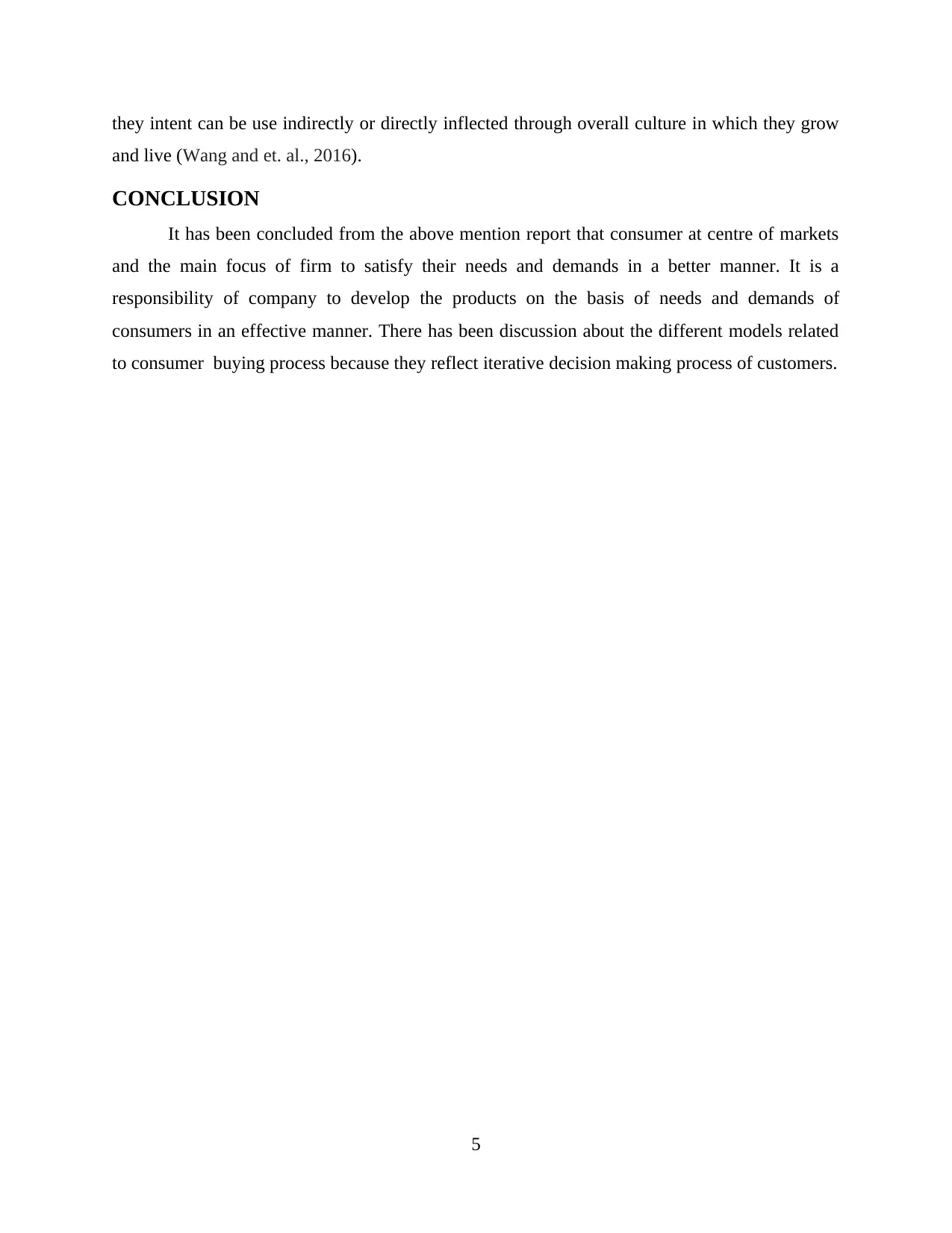
they intent can be use indirectly or directly inflected through overall culture in which they grow
and live (Wang and et. al., 2016).
CONCLUSION
It has been concluded from the above mention report that consumer at centre of markets
and the main focus of firm to satisfy their needs and demands in a better manner. It is a
responsibility of company to develop the products on the basis of needs and demands of
consumers in an effective manner. There has been discussion about the different models related
to consumer buying process because they reflect iterative decision making process of customers.
5
and live (Wang and et. al., 2016).
CONCLUSION
It has been concluded from the above mention report that consumer at centre of markets
and the main focus of firm to satisfy their needs and demands in a better manner. It is a
responsibility of company to develop the products on the basis of needs and demands of
consumers in an effective manner. There has been discussion about the different models related
to consumer buying process because they reflect iterative decision making process of customers.
5
Paraphrase This Document
Need a fresh take? Get an instant paraphrase of this document with our AI Paraphraser
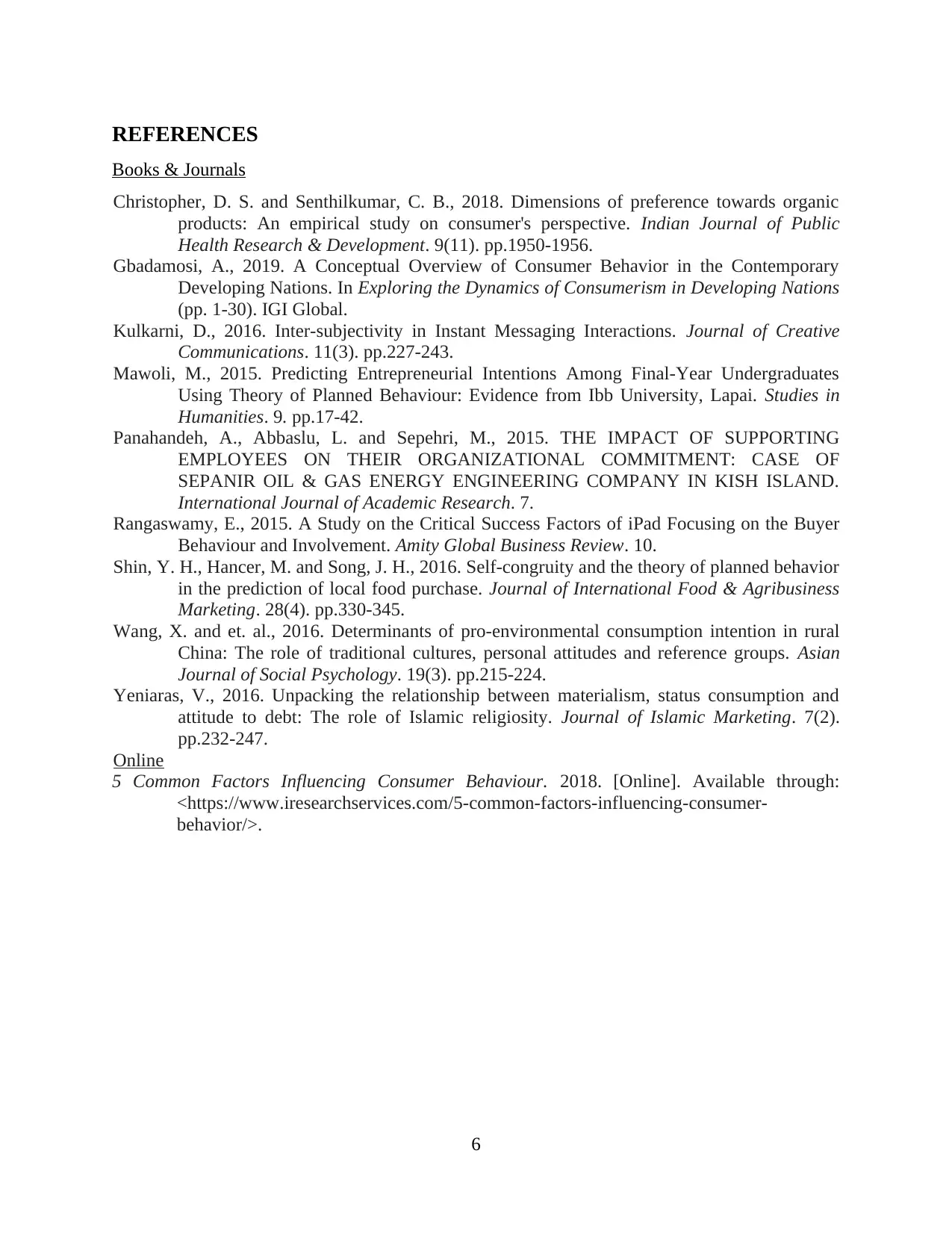
REFERENCES
Books & Journals
Christopher, D. S. and Senthilkumar, C. B., 2018. Dimensions of preference towards organic
products: An empirical study on consumer's perspective. Indian Journal of Public
Health Research & Development. 9(11). pp.1950-1956.
Gbadamosi, A., 2019. A Conceptual Overview of Consumer Behavior in the Contemporary
Developing Nations. In Exploring the Dynamics of Consumerism in Developing Nations
(pp. 1-30). IGI Global.
Kulkarni, D., 2016. Inter-subjectivity in Instant Messaging Interactions. Journal of Creative
Communications. 11(3). pp.227-243.
Mawoli, M., 2015. Predicting Entrepreneurial Intentions Among Final-Year Undergraduates
Using Theory of Planned Behaviour: Evidence from Ibb University, Lapai. Studies in
Humanities. 9. pp.17-42.
Panahandeh, A., Abbaslu, L. and Sepehri, M., 2015. THE IMPACT OF SUPPORTING
EMPLOYEES ON THEIR ORGANIZATIONAL COMMITMENT: CASE OF
SEPANIR OIL & GAS ENERGY ENGINEERING COMPANY IN KISH ISLAND.
International Journal of Academic Research. 7.
Rangaswamy, E., 2015. A Study on the Critical Success Factors of iPad Focusing on the Buyer
Behaviour and Involvement. Amity Global Business Review. 10.
Shin, Y. H., Hancer, M. and Song, J. H., 2016. Self-congruity and the theory of planned behavior
in the prediction of local food purchase. Journal of International Food & Agribusiness
Marketing. 28(4). pp.330-345.
Wang, X. and et. al., 2016. Determinants of pro‐environmental consumption intention in rural
China: The role of traditional cultures, personal attitudes and reference groups. Asian
Journal of Social Psychology. 19(3). pp.215-224.
Yeniaras, V., 2016. Unpacking the relationship between materialism, status consumption and
attitude to debt: The role of Islamic religiosity. Journal of Islamic Marketing. 7(2).
pp.232-247.
Online
5 Common Factors Influencing Consumer Behaviour. 2018. [Online]. Available through:
<https://www.iresearchservices.com/5-common-factors-influencing-consumer-
behavior/>.
6
Books & Journals
Christopher, D. S. and Senthilkumar, C. B., 2018. Dimensions of preference towards organic
products: An empirical study on consumer's perspective. Indian Journal of Public
Health Research & Development. 9(11). pp.1950-1956.
Gbadamosi, A., 2019. A Conceptual Overview of Consumer Behavior in the Contemporary
Developing Nations. In Exploring the Dynamics of Consumerism in Developing Nations
(pp. 1-30). IGI Global.
Kulkarni, D., 2016. Inter-subjectivity in Instant Messaging Interactions. Journal of Creative
Communications. 11(3). pp.227-243.
Mawoli, M., 2015. Predicting Entrepreneurial Intentions Among Final-Year Undergraduates
Using Theory of Planned Behaviour: Evidence from Ibb University, Lapai. Studies in
Humanities. 9. pp.17-42.
Panahandeh, A., Abbaslu, L. and Sepehri, M., 2015. THE IMPACT OF SUPPORTING
EMPLOYEES ON THEIR ORGANIZATIONAL COMMITMENT: CASE OF
SEPANIR OIL & GAS ENERGY ENGINEERING COMPANY IN KISH ISLAND.
International Journal of Academic Research. 7.
Rangaswamy, E., 2015. A Study on the Critical Success Factors of iPad Focusing on the Buyer
Behaviour and Involvement. Amity Global Business Review. 10.
Shin, Y. H., Hancer, M. and Song, J. H., 2016. Self-congruity and the theory of planned behavior
in the prediction of local food purchase. Journal of International Food & Agribusiness
Marketing. 28(4). pp.330-345.
Wang, X. and et. al., 2016. Determinants of pro‐environmental consumption intention in rural
China: The role of traditional cultures, personal attitudes and reference groups. Asian
Journal of Social Psychology. 19(3). pp.215-224.
Yeniaras, V., 2016. Unpacking the relationship between materialism, status consumption and
attitude to debt: The role of Islamic religiosity. Journal of Islamic Marketing. 7(2).
pp.232-247.
Online
5 Common Factors Influencing Consumer Behaviour. 2018. [Online]. Available through:
<https://www.iresearchservices.com/5-common-factors-influencing-consumer-
behavior/>.
6
1 out of 8
Related Documents
Your All-in-One AI-Powered Toolkit for Academic Success.
+13062052269
info@desklib.com
Available 24*7 on WhatsApp / Email
![[object Object]](/_next/static/media/star-bottom.7253800d.svg)
Unlock your academic potential
Copyright © 2020–2025 A2Z Services. All Rights Reserved. Developed and managed by ZUCOL.





